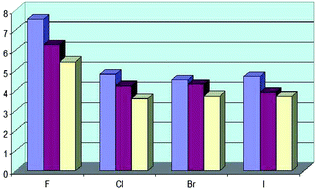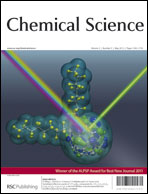Hydrogen bonds with fluorine. Studies in solution, in gas phase and by computations, conflicting conclusions from crystallographic analyses
Abstract
Hydrogen bonds with organic fluorine are discussed on the background of an ongoing controversy, with an overview on the different methods of investigation, and with many examples, reaching from simple complexes to those involving nucleic acids. Often overlooked experimental values for the free energy of hydrogen bond involving C–F as acceptor depend on the solvent; in CCl4 they amount with moderately acidic donors to ΔG = 6 kJ mol−1, much higher than with other halogens, placing fluorine as an acceptor between alkanes and arenes. The measured ΔG values increase from primary to secondary to tertiary C–F moieties, ab initio calculations predict an increase from sp3 to sp2 to sp1 carbon. Simultaneous action of several X–H⋯F bridges can lead, even in polar media such as CDCl3/CD3CN, to binding constants of 70 [M−1]. Spectroscopic measurements unequivocally establish the presence of such hydrogen bonds, furnishing H⋯F distances as small as 2.02 Å, and X–H⋯F angles close to 180°, which generally agrees with most computational analyses. All computations point to dominating dispersive contributions, in particular for the very weak C–H⋯F interactions. In contrast, crystallographic analyses have led to controversial conclusions. Screening of databases, essentially based on X-ray determinations, often showed only very few structures with short H⋯F distances, for which reason the existence of such hydrogen bonds has been generally questioned. Some database evaluations, however, have shown enough cases for interactions between fluorine and X–H donors, mostly with H⋯F distances around 2.5 Å and X–H⋯F angles around 130°, which makes it difficult to distinguish hydrogen bonds from dispersive interactions. In several cases intermolecular H⋯F bridges dominate, and play a significant role in packing motifs, even when the underlying molecules tend to form only intramolecular bridges in solution. Generally, structures with intramolecular bonds give a clearer picture of X–H⋯F geometries. The limitations in deriving from crystal studies non-covalent binding mechanisms for weak single interactions are discussed.

- This article is part of the themed collection: 1st International Conference on Noncovalent Interactions

 Please wait while we load your content...
Please wait while we load your content...